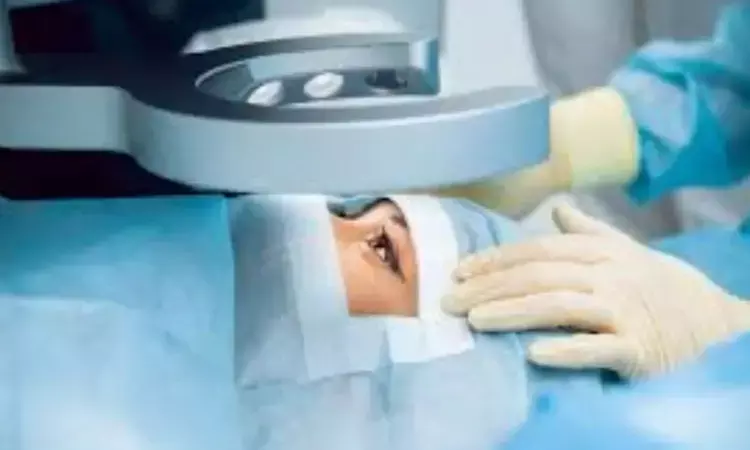- Home
- Medical news & Guidelines
- Anesthesiology
- Cardiology and CTVS
- Critical Care
- Dentistry
- Dermatology
- Diabetes and Endocrinology
- ENT
- Gastroenterology
- Medicine
- Nephrology
- Neurology
- Obstretics-Gynaecology
- Oncology
- Ophthalmology
- Orthopaedics
- Pediatrics-Neonatology
- Psychiatry
- Pulmonology
- Radiology
- Surgery
- Urology
- Laboratory Medicine
- Diet
- Nursing
- Paramedical
- Physiotherapy
- Health news
- Fact Check
- Bone Health Fact Check
- Brain Health Fact Check
- Cancer Related Fact Check
- Child Care Fact Check
- Dental and oral health fact check
- Diabetes and metabolic health fact check
- Diet and Nutrition Fact Check
- Eye and ENT Care Fact Check
- Fitness fact check
- Gut health fact check
- Heart health fact check
- Kidney health fact check
- Medical education fact check
- Men's health fact check
- Respiratory fact check
- Skin and hair care fact check
- Vaccine and Immunization fact check
- Women's health fact check
- AYUSH
- State News
- Andaman and Nicobar Islands
- Andhra Pradesh
- Arunachal Pradesh
- Assam
- Bihar
- Chandigarh
- Chattisgarh
- Dadra and Nagar Haveli
- Daman and Diu
- Delhi
- Goa
- Gujarat
- Haryana
- Himachal Pradesh
- Jammu & Kashmir
- Jharkhand
- Karnataka
- Kerala
- Ladakh
- Lakshadweep
- Madhya Pradesh
- Maharashtra
- Manipur
- Meghalaya
- Mizoram
- Nagaland
- Odisha
- Puducherry
- Punjab
- Rajasthan
- Sikkim
- Tamil Nadu
- Telangana
- Tripura
- Uttar Pradesh
- Uttrakhand
- West Bengal
- Medical Education
- Industry
Peribulbar anaesthesia in ophthalmic surgery linked to development of pulmonary oedema

Researchers have found in new study that Peribulbar anaesthesia in ophthalmic surgery was linked to development of pulmonary oedema. Further it was found that majority of patients developed Pulmonary oedema during vitreoretinal procedures, particularly diabetic vitrectomies.
The research has been published in the Indian Journal of Anaesthesia.
Recently published research investigates the occurrence of pulmonary edema (PE) in patients undergoing ophthalmic surgeries under regional anaesthesia.
The study is a retrospective observational analysis of patients who developed Pulmonary oedema during ophthalmic surgical procedures scheduled between 2019 and 2021. A total of 56,334 surgeries performed under regional anaesthesia were studied, and 27 patients (0.047%) developed Pulmonary oedema. The mean age of occurrence was 55.8 years, with hypertension and diabetes being the most common comorbidities among the affected patients. The majority of patients developed Pulmonary oedema during vitreoretinal procedures, particularly diabetic vitrectomies. Symptoms included breathing discomfort, tachypnoea, tachycardia, elevated blood pressure, and decreased oxygen saturation levels. The authors note that the incidence of Pulmonary oedema in this study was higher than the previously reported 0.006% incidence of major systemic complications in patients receiving peri-bulbar block. They also discuss the association between PE occurrence and the use of phenyl epinephrine eye drops, as well as the impact of underlying systemic comorbidities on lowering the threshold for Pulmonary oedema development. The paper suggests that slow diffusion of local anaesthetics into the medulla and suboptimal ventricular function due to systemic comorbid conditions may contribute to the development of Pulmonary oedema in these patients. The study provides valuable insights into the incidence and associated factors of Pulmonary oedema in ophthalmic surgeries under regional anaesthesia, highlighting the need for further research to understand and prevent such complications in this patient population.
Reference -
Kasanavesi, Ramakrishna Chaitanya; Dave, Vivek Pravin1; Jalali, Subhadra1; Rao, Rajanarsing. Pulmonary oedema in ophthalmic surgeries under peribulbar anaesthesia: A retrospective analysis. Indian Journal of Anaesthesia 67(11):p 1009-1010, November 2023. | DOI: 10.4103/ija.ija_623_23
MBBS, MD (Anaesthesiology), FNB (Cardiac Anaesthesiology)
Dr Monish Raut is a practicing Cardiac Anesthesiologist. He completed his MBBS at Government Medical College, Nagpur, and pursued his MD in Anesthesiology at BJ Medical College, Pune. Further specializing in Cardiac Anesthesiology, Dr Raut earned his FNB in Cardiac Anesthesiology from Sir Ganga Ram Hospital, Delhi.
Dr Kamal Kant Kohli-MBBS, DTCD- a chest specialist with more than 30 years of practice and a flair for writing clinical articles, Dr Kamal Kant Kohli joined Medical Dialogues as a Chief Editor of Medical News. Besides writing articles, as an editor, he proofreads and verifies all the medical content published on Medical Dialogues including those coming from journals, studies,medical conferences,guidelines etc. Email: drkohli@medicaldialogues.in. Contact no. 011-43720751


